Bouillon de Pied de Boeuf (Beef’s Foot Soup) – A Hearty Caribbean Classic
If there’s one dish that truly warms you from the inside out and leaves you feeling like you can conquer the world (or at least your to-do list), it’s Bouillon de Pied de Boeuf—Beef’s Foot Soup.
This Haitian favorite is not just a meal, it’s a whole experience: a savory broth loaded with vegetables, dumplings, and the rich, nourishing goodness of beef feet, also known as cow’s feet.
This soup is famous for being filling, comforting, and downright nutritious—thanks to the collagen-rich bones that give the broth its silky texture and incredible depth of flavor. And yes, your grandmother was right: it’s good for your joints, skin, and overall well-being.
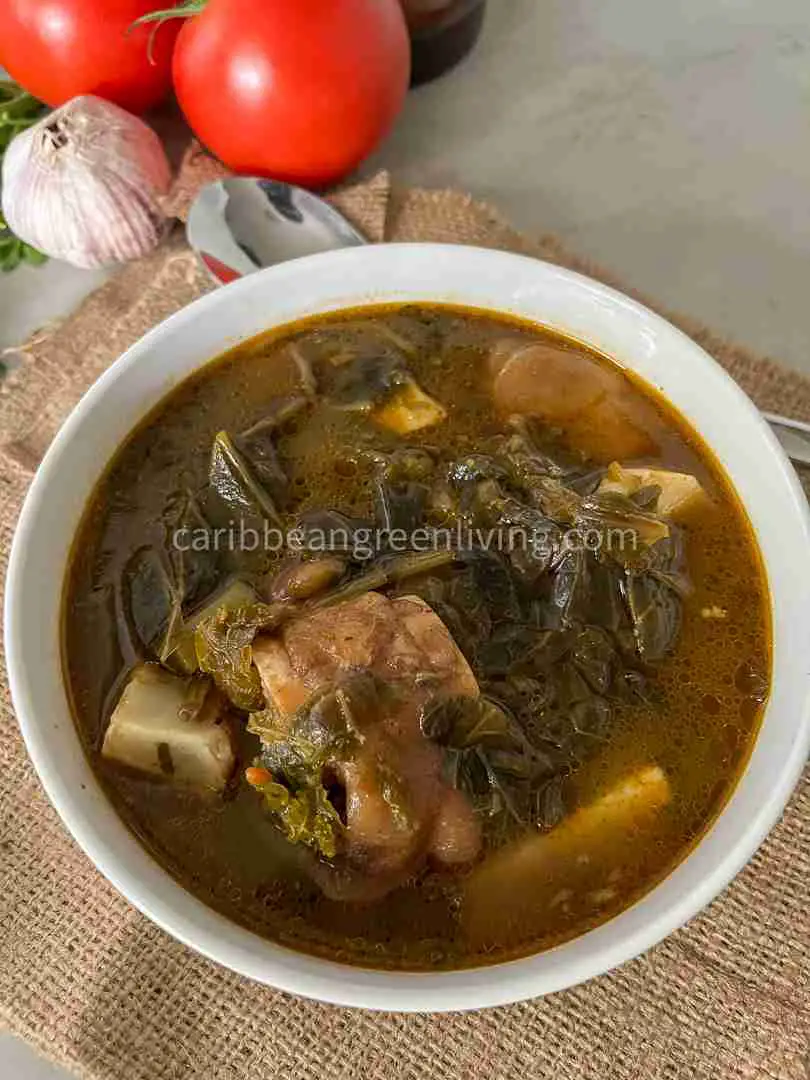
Why You’ll Love This Recipe
- It’s nutrient-dense – Beef feet are full of collagen, which supports healthy joints, skin elasticity, and digestion.
- It’s hearty and satisfying – Packed with vegetables, dumplings, and slow-cooked meat, this soup is a complete meal in a bowl.
- It’s versatile – Swap out vegetables depending on what’s in season or what you have on hand.
- It’s traditional with a modern twist – The recipe below includes a kale variation that’s just as delicious as the original cabbage version.
This Bouillon de Pied de Boeuf is similar to the authentic Haitian bouillon traditionally made with beef meat and beef bones. In Haiti, bouillon is also prepared with goat meat and goat bones—or even the goat’s head—for a deep, rustic flavor. The most common vegetables in these hearty soups are cabbage, carrots, and spinach. I personally love adding watercress, which brings a mild, peppery kick that brightens the broth. And if you really want a vegetable that delivers both exceptional nutritional value and a wonderful flavor in soups or legumes, try adding dandelion greens—they’re a hidden Caribbean kitchen gem.
Ingredient Descriptions for The Bouillon de Pied de Boeuf
- Haitian epis (seasoning base): Flavor-packed blend of herbs, peppers, and aromatics—key to authentic Haitian taste.
- Beef’s foot (8–12 pieces, cleaned): Collagen-rich cuts that create a flavorful, silky broth when slow-cooked.
- Green bananas (2): Adds subtle sweetness and starch for body in the soup.
- Potatoes (2): Classic root vegetable that absorbs the savory broth beautifully.
- Caribbean yam (½ pound): Earthy, mildly sweet root that adds depth and texture.
- Tomatoes (2): Balances the richness with natural acidity.
- Onions (2 medium): Builds the flavor base for the soup.
- White cabbage (3 leaves) or kale: Adds freshness and gentle crunch; kale offers a slightly earthy note.
- Watercress (1 bunch): Peppery and fresh, it brightens the soup.
- Garlic (6 cloves, crushed): Aromatic and flavorful—essential for Haitian cooking.
- Parsley (½ tablespoon, chopped): Fresh herbal lift.
- Thyme (3 sprigs): Infuses warm, earthy notes into the broth.
- Salt and pepper (to taste): Enhances and balances flavors.
- Dombwey (12 dumpling balls – optional): Chewy, satisfying addition to the soup.
- Lemon juice (1 teaspoon): Finishes the dish with a hint of brightness.
Benefits of Beef Foot Soup
- Collagen boost – Supports joint, skin, and gut health
- Nutrient-rich broth – Minerals and amino acids from bones and connective tissues
- Energy & warmth – Perfect for recovery, rainy days, or when you just need comfort in a bowl
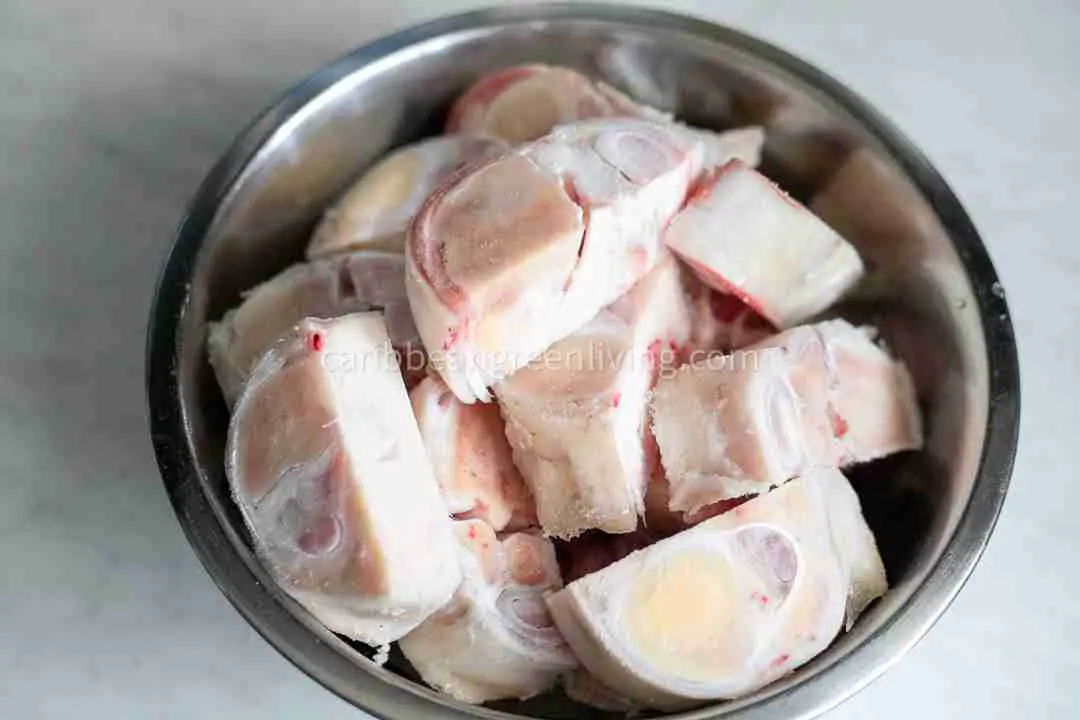
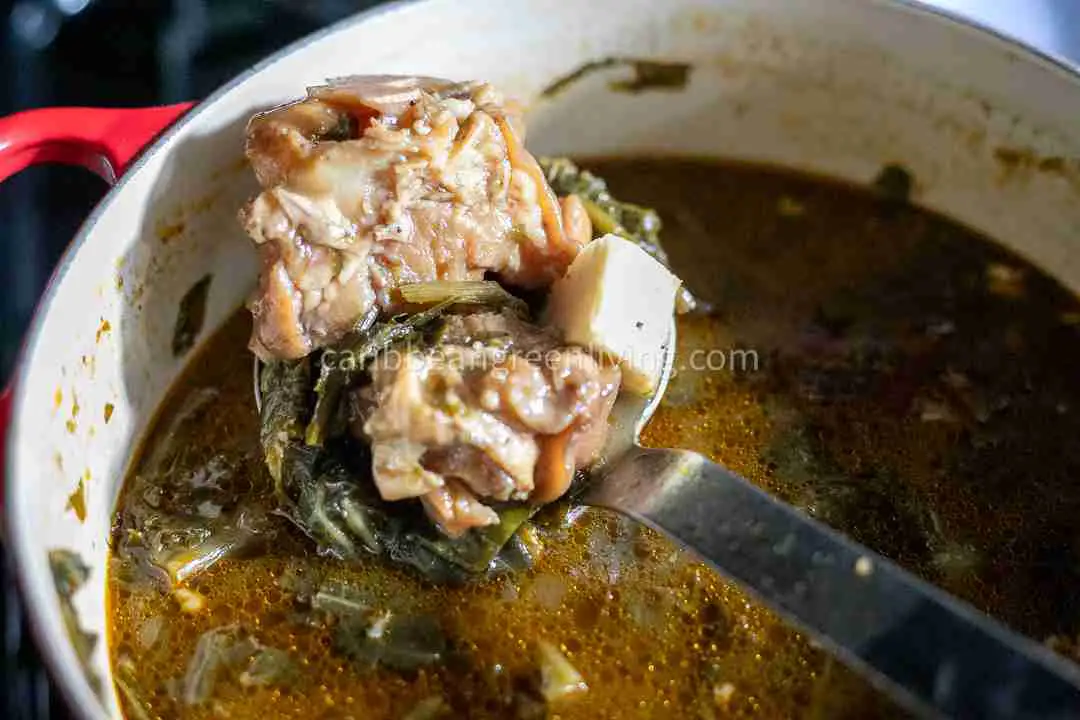
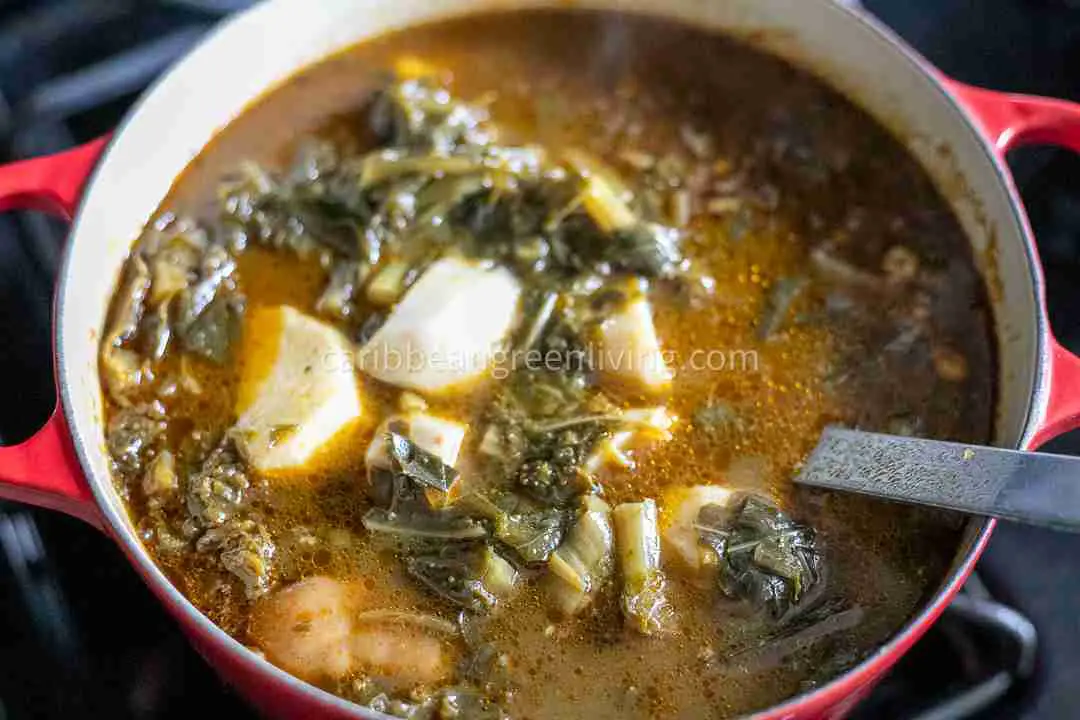
My Kale Version for Cow’s Foot Recipe
If cabbage isn’t your thing (or you just love kale), simply omit the cabbage leaves and add shredded kale instead—stems removed for a softer texture. Kale brings a slightly earthy note and holds up beautifully in soup without becoming mushy.
Vegetable Variations for Traditional Caribbean Soup
You can mix and match vegetables based on your taste and availability:
- Leafy Greens: Cabbage, kale, watercress, mustard greens (go easy—they’re strong!), collard greens
- Root & Starchy Veg: Plantains, Caribbean yams, sweet potatoes, yuca, malanga
Dumpling or No Dumpling?
Dombwey (dumplings) are traditional and add that chewy, satisfying bite. But if you’re cutting back on carbs or already have plenty from the bananas and root vegetables, you can absolutely skip them.
Can I Add Other Meats?
Absolutely. While beef feet are the star here, you can add:
- Other beef cuts (shank, brisket, or stew meat)
- Pork
- Veal
- Lamb
- Goat
The key is to balance flavors and avoid overpowering the broth’s natural richness.
Cooking Notes & Tips for This Haitian Comfort Food
What are beef feet?
Beef (or cow) feet are the lower part of the cow’s leg, packed with bones, tendons, and connective tissue. When slow-cooked, they release collagen that gives the broth body and a luxurious mouthfeel.
How to buy beef feet:
Look for fresh, cleanly cut pieces at a Caribbean, African, or Latin American butcher. They’re often sold frozen in supermarkets that carry international foods.
How to cook them tender quickly:
A pressure cooker is your best friend here. What could take 3–4 hours on the stovetop becomes tender perfection in about 30 minutes under pressure.
Bouillon de Pied de Boeuf isn’t just a recipe—it’s heritage in a pot. Whether you stick to the classic cabbage version or try my kale twist, you’ll end up with a deeply flavorful, soul-warming soup that brings people together around the table.
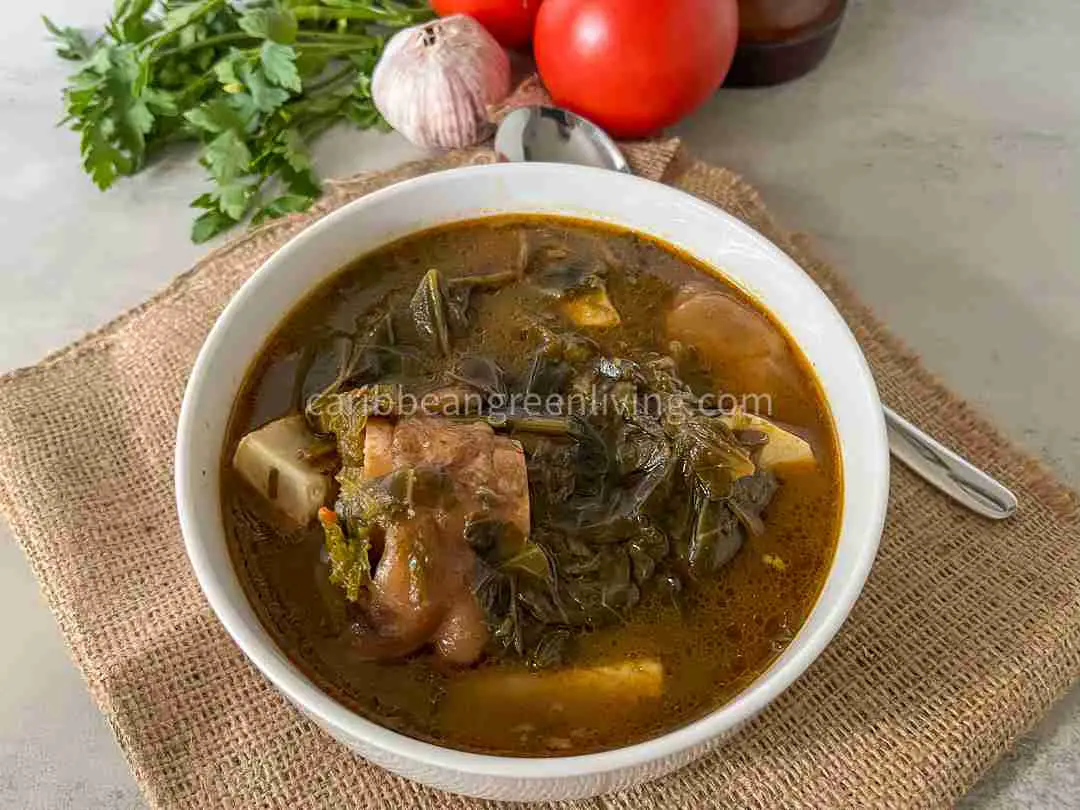
Cultural Notes
Bouillon is a cornerstone of Haitian home cooking—a hearty, nourishing soup that often appears on weekends, family gatherings, or special occasions. While Bouillon de Pied de Boeuf focuses on the rich, gelatinous flavors of beef feet, authentic Haitian bouillon is traditionally made with beef meat and beef bones for a robust, meaty broth. In many regions, it’s also prepared with goat meat and goat bones—or even the goat’s head—for a deeper, rustic taste that’s beloved across the island.
The vegetable mix in a classic Haitian bouillon usually includes cabbage, carrots, and spinach. Every cook has their own personal twist, and mine is adding fresh watercress for its mild, peppery bite that brightens the broth. If you’re looking for a leafy green that’s both incredibly nutritious and delicious in soups or legumes, try dandelion greens—they’re a flavorful, health-packed addition that deserves a spot in your Caribbean kitchen.
References
- U.S. Department of Agriculture (USDA) FoodData Central. Beef, variety meats and by-products, feet, cooked, simmered. Retrieved from: https://fdc.nal.usda.gov
- The Spruce Eats. Cow Foot Soup Recipe. Retrieved from: https://www.thespruceeats.com
- Serious Eats. A Guide to Cooking with Collagen-Rich Cuts of Meat. Retrieved from: https://www.seriouseats.com
- Caribbean Journal. Traditional Haitian Cuisine and Comfort Foods. Retrieved from: https://www.caribjournal.com
- Jamaica Observer. Cow Foot Soup – A Caribbean Classic. Retrieved from: https://www.jamaicaobserver.com

Bouillon de Pied de Boeuf, or Beef’s Foot Soup
Equipment
- Large pressure cooker (for faster cooking) or large soup pot
- Sharp chef’s knife
- Mixing bowls (for prepping vegetables and dumplings)
- Wooden spoon or soup ladle
- Tongs (to handle hot beef foot pieces)
Ingredients
- 8 –12 pieces of beef’s foot cleaned
- 2 green bananas
- 2 potatoes
- 1 Caribbean yam about ½ pound
- 2 tomatoes
- 2 medium onions
- 3 leaves of white cabbage or substitute kale for my twist
- 1 bunch watercress
- 6 garlic cloves crushed
- ½ tablespoon chopped parsley
- 3 thyme sprigs
- Salt and pepper to taste
- 12 balls of dombwey dumplings – optional
- 1 teaspoon lemon juice
- Haitian epis seasoning base
Instructions
Clean the Beef’s Foot
- Rinse the beef’s foot pieces in lemon water to remove any impurities.
Pressure Cook for Tenderness
- Place the cleaned pieces in a pressure cooker with Haitian epis and 1 medium onion. Cook over medium heat for 30 minutes.
- Tip: This step ensures tender meat and gelatin-rich broth without hours of simmering.
Add Vegetables & Dumplings
- Once the beef is tender, add the vegetables (cut into medium pieces) and the dumpling balls. Add enough water to completely cover the ingredients.
Season & Simmer
- Adjust seasoning with salt and pepper. Cook over medium heat until the vegetables are tender and the flavors have melded.
Finish with Lemon Juice
- Just before serving, stir in the lemon juice for a bright, fresh finish.
Serve Hot
- Ladle into bowls and serve immediately. A side of fresh bread or fried plantains pairs beautifully.
Notes
- The amount of Haitian epis depends on the quantity of beef feet. For 3 pounds, add about 3–4 tablespoons. If your epis contains no salt, you can add more.
- You can use seasoning salt or beef/chicken bouillon seasoning instead of regular salt.
- Flavor variations: Add lemon pepper, Italian seasoning, a touch of smoked paprika, or cumin for a unique twist.
- For a softer leafy green, substitute cabbage with shredded kale, collard greens, mustard greens, or a mix.
- Pressure cooking drastically reduces cooking time—about 30 minutes versus hours of simmering.
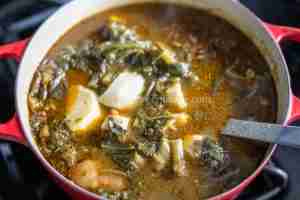
Nutrition
Please keep in mind that nutritional information is a rough estimate and can vary greatly based on the products used.
Nutrition info is automatically generated and provided as a courtesy and as an estimate only.






